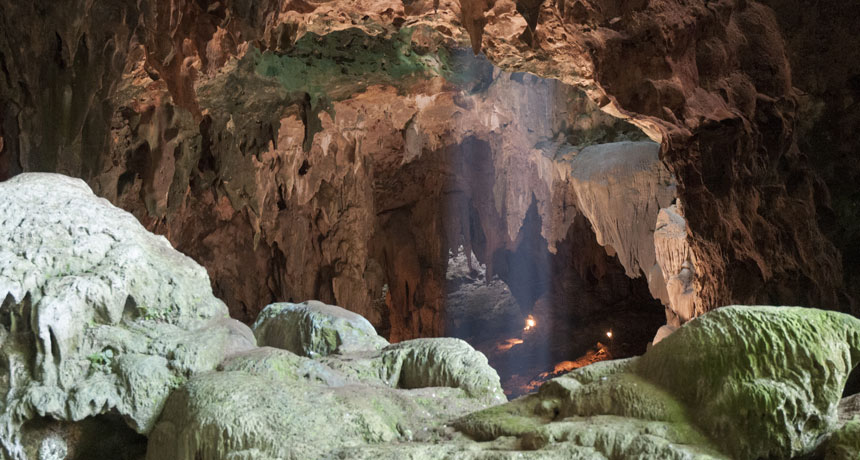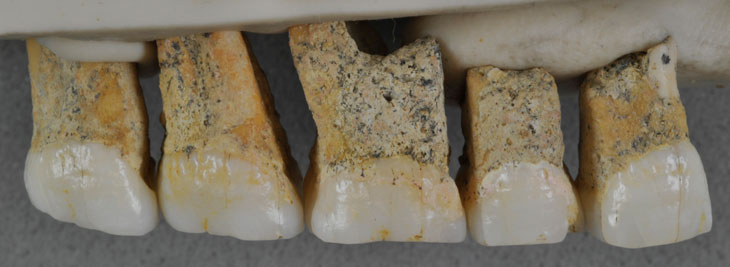A new hominid species has been found in a Philippine cave, fossils suggest
The newly dubbed Homo luzonensis lived at least 50,000 years ago, scientists say

CAVE SPECIES Fossils unearthed in this cave in the Philippines are from a previously unknown Homo species that lived at least 50,000 years ago, scientists announced.
Callao Cave Archaeology Project
A new member of the human genus has been found in a cave in the Philippines, researchers report.
Fossils with distinctive features indicate that the hominid species inhabited the island now known as Luzon at least 50,000 years ago, according to a study in the April 11 Nature. That species, which the scientists have dubbed Homo luzonensis, lived at the same time that controversial half-sized hominids named Homo floresiensis and nicknamed hobbits were roaming an Indonesian island to the south called Flores (SN: 7/9/16, p. 6).
In shape and size, some of the fossils match those of corresponding bones from other Homo species. “But if you take the whole combination of features for H. luzonensis, no other Homo species is similar,” says study coauthor and paleoanthropologist Florent Détroit of the French National Museum of Natural History in Paris.
If the find holds up to further scientific scrutiny, it would add to recent fossil and DNA evidence indicating that several Homo lineages already occupied East Asia and Southeast Asian islands by the time Homo sapiens reached what’s now southern China between 80,000 and 120,000 years ago (SN: 11/14/15, p. 15). The result: an increasingly complicated picture of hominid evolution in Asia.
Excavations in 2007, 2011 and 2015 at Luzon’s Callao Cave yielded a dozen H. luzonensis fossils at first — seven isolated teeth (five from the same individual), two finger bones, two toe bones and an upper leg bone missing its ends, the scientists say. Analysis of the radioactive decay of uranium in one tooth suggested a minimum age of 50,000 years. Based on those fossils, a hominid foot bone found in 2007 in the same cave sediment was also identified as H. luzonensis. It dates to at least 67,000 years ago.

It’s unclear whether H. luzonensis was as small as hobbits, Détroit says. The best-preserved hobbit skeleton comes from a female who stood about a meter tall. Based on the length of the Callao Cave foot bone, Détroit’s team suspects that H. luzonensis was taller than that, although still smaller than most human adults today.
As with hobbits, H. luzonensis’ evolutionary origins are unknown. Scientists think that hobbits may have descended from seagoing H. erectus groups, and perhaps H. luzonensis did too, writes paleoanthropologist Matthew Tocheri of Lakehead University in Thunder Bay, Canada, in a commentary published with the new report. Evidence suggests that hominids reached Luzon by around 700,000 years ago (SN Online: 5/2/18). So H. erectus may have also crossed the sea from other Indonesian islands or mainland Asia to Luzon and then evolved into H. luzonensis with its smaller body and unusual skeletal traits, Détroit speculates, a process known as island dwarfing.
But some scientists not involved in the research say it’s too soon to declare the Luzon fossils a brand-new Homo species. Détroit’s group, so far, has been unable to extract ancient DNA from the fossils. So “all [evolutionary] possibilities must remain open,” says archaeologist Katerina Douka of the Max Planck Institute for the Science of Human History in Jena, Germany.
The mosaic of fossil features that the team interprets as distinctive, for instance, may have been a product of interbreeding between two or more earlier Homo species, creating hybrids, but not a new species.
Or perhaps a small population of, say, H. erectus that survived on an isolated island like Luzon for possibly hundreds of thousands of years simply acquired some skeletal features that its mainland peers lacked, rather than evolving into an entirely new species, says paleoanthropologist María Martinón-Torres.
Those questions make the new fossils “an exciting and puzzling discovery,” says Martinón-Torres, director of the National Research Centre on Human Evolution in Burgos, Spain.
If the unusual teeth and climbing-ready hand and foot bones found at Callao Cave occurred as a package among Luzon’s ancient Homo crowd, “then that combination is unique and unknown so far” among hominids, Martinón-Torres says. Only a more complete set of fossils, ideally complemented by ancient DNA, she adds, can illuminate whether such traits marked a new Homo member.







